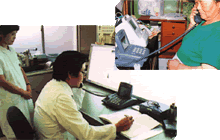 |
 |
 |
 |
 |
 |
|||||
 |
 |
 |
 |
|
MULTIMEDIA BLITZ: A Big Experiment for a Small Village February 25, 2000
The remote farming village of Katsurao, Fukushima Prefecture, home to only 1,870 people, is the unlikely focus of a multimedia venture now making waves both in Japan and overseas. Since its launch in April 1999, the Katsuraomura Multi Media Village has attracted a constant stream of visitors from around the country, and has been featured in media as far away as the New York Times. All 470 village households are connected to the KMMV, a system of videophones allowing families to stay in touch with the village office, hospitals, and schools. The cost of networking the village was 75 million yen (714,000 U.S. dollars at 105 yen to the dollar), with a third of the funds coming from Japan's Ministry of Posts and Telecommunications and a third from Fukushima Prefecture. Remote Medical Checkups Initial physical examinations are carried out in person at the hospital, but subsequent checkups can be handled remotely. After making an appointment with the hospital, the patient connects with a doctor over the videophone network. The network can also be used to transmit data on the patient's daily health, making checkups more complete. Even prescriptions can be filled over the network and delivered right to the patient's door. More than 60 villagers are now using the remote health-check system and enjoying the freedom that comes with the decreased travel burden. Distance Learning The network also serves as a storehouse of information on the village itself. Residents can use the videophones to call up images of and information on life in the village, municipal administration, and local events. This has greatly boosted the availability of information that was once a chore to obtain. Keep in Touch the Easy Way According to village officials, there were worries at first that elderly villagers would find themselves at a loss when confronted with the new technology. But users of all ages have gotten completely used to the machines, and are using them in many ways in their daily lives. Many of Japan's farming communities are facing problems relating to dropping and aging populations, and representatives from local governments across the country have made the trip to Katsurao to see the network in action. Projects similar to the KMMV may one day breathe new life into villages throughout Japan.  Edited
by Japan Echo Inc. based on domestic Japanese news sources. Articles presented
here are offered for reference purposes and do not necessarily represent
the policy or views of the Japanese Government. Edited
by Japan Echo Inc. based on domestic Japanese news sources. Articles presented
here are offered for reference purposes and do not necessarily represent
the policy or views of the Japanese Government.
|


